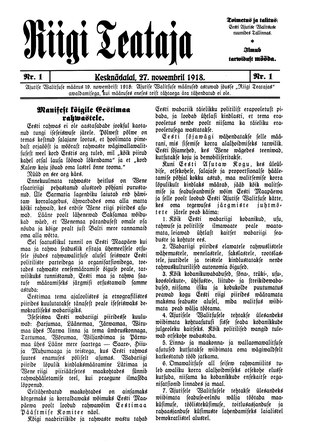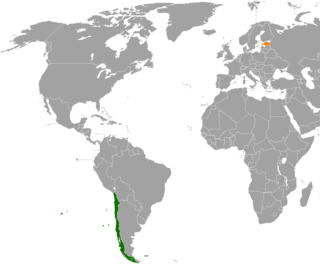Related Research Articles
The Republic of Estonia gained its independence from the Russian Empire on 24 February 1918 and established diplomatic relations with many countries via membership of the League of Nations. The forcible incorporation of Estonia into the Soviet Union in 1940 was not generally recognised by the international community and the Estonian diplomatic service continued to operate in some countries. Following the restoration of independence from the Soviet Union, Russia was one of the first nations to re-recognize Estonia's independence. Estonia's immediate priority after regaining its independence was the withdrawal of Russian forces from Estonian territory. In August 1994, this was completed. However, relations with Moscow have remained strained primarily because Russia decided not to ratify the border treaty it had signed with Estonia in 1999.

The flag of Estonia is a tricolour featuring three equal horizontal bands of blue (top), black (middle), and white (bottom). In Estonian it is colloquially called the sinimustvalge.

The maple leaf is the characteristic leaf of the maple tree. It is most widely recognized as the national symbol of Canada.

Eur-Lex is an official website of European Union law and other public documents of the European Union (EU), published in 24 official languages of the EU. The Official Journal (OJ) of the European Union is also published on EUR-Lex. Users can access EUR-Lex free of charge and also register for a free account, which offers extra features.
ERT may refer to:

Lesbian, gay, bisexual, and transgender (LGBT) rights in Estonia have advanced significantly over the course of the last few decades, especially since the turn of the 21st century. Among the countries which after World War II were controlled by the former Soviet Union, independent Estonia is now considered to be one of the most liberal when it comes to LGBT rights. There is a notable age gap, as younger people tend to be more tolerant and liberal, while older people tend to be more socially conservative.
Riigihoidja was the name of the office of the head of state and head of the caretaker government of Estonia from 3 September 1937 to 24 April 1938. The first person to hold this position was Konstantin Päts, five time former State Elder. His eventual successor ex officio was Johan Laidoner, then Commander-in-Chief.
Electronic voting in Estonia gained popularity in 2001 with the "e-minded" coalition government. In 2005, it became the first nation to hold legally binding general elections over the Internet with their pilot project for municipal elections. Estonian election officials declared the electronic voting system a success and found that it withstood the test of real-world use.
Constitution of Estonia is the fundamental law of the Republic of Estonia and establishes the state order as that of a democratic republic where the supreme power is vested in its citizens. The first Constitution was adopted by the freely elected Estonian Constituent Assembly on 15 June 1920 and came into force on 21 December 1920. Heavily amended on 24 January 1934, following a referendum in 1933, it was in force until the second Constitution was enacted on 1 January 1938. It remained in force, de facto, until 16 June 1940, when the Soviet Union occupied Estonia and, de jure, until 28 June 1992, when the third and current Constitution of the Republic of Estonia was adopted by referendum.

The Estonian identity card is a mandatory identity document for citizens of Estonia. In addition to regular identification of a person, an ID-card can also be used for establishing one's identity in electronic environment and for giving one's digital signature. Within Europe as well as French overseas territories, Georgia and Tunisia the Estonian ID-card can be used by the citizens of Estonia as a travel document.

Riigi Teataja is a public journal of the Republic of Estonia. The first issue was published on 27 November 1918.

Riigikantselei is an executive office of Republic of Estonia. The office's purpose is to support the Republic's executive branch in enacting the political decisions. It is also known for its responsibility to publish Riigi Teataja and its electronic counterpart, Elektrooniline Riigi Teataja.
Protected areas of Estonia are regulated by the Nature Conservation Act, which was passed by the Estonian parliament on April 21, 2004 and entered into force May 10, 2004. Overall Estonia has 15403 protected areas covering 21% of the country land and 18% of it marine and coastal territory, including 6 national parks: Lahemaa National Park, Karula National Park, Soomaa National Park,Vilsandi National Park, Matsalu National Park, and Alutaguse National Park

Chile–Estonia relations are foreign relations between Chile and Estonia. Chile re-recognized Estonia on August 28, 1991 and diplomatic relations between the two countries were established on September 27, 1991. Chile is represented in Estonia through its ambassador who resides in Helsinki (Finland) and through an honorary consulate in Tallinn. Estonia is represented in Chile through an honorary consulate in Santiago. The current Chilean ambassador to Estonia, Carlos Parra Merino, officially presented his credentials to the Estonian President Toomas Hendrik Ilves in June 2007. Carlos Parra Merino resides in Helsinki.

Abortion in Estonia has been legal since 23 November 1955, when Estonia was part of the Soviet Union. Estonia fine-tuned their legislation after the restoration of independence.
The 1 kroon coin was put in circulation from 1 August 1934 to 25 March 1941, during the first independence period of Estonia. The exact number of coins minted is not known, as part of the archives was destroyed in the war, but some data indicate that about 3,406,066 pieces were struck. Between 1935 and 1936, 1,586,000 1 kroon coins were minted. Designed by graphic artist Günther Reindorff, it depicts the image of a 13th-century Viking cargo ship.

As per Estonian traffic act § 15, the general speed limits in Estonia are:
The general notion of cryptocurrencies in Europe denotes the processes of legislative regulation, distribution, circulation, and storage of cryptocurrencies in Europe. In April 2023, the EU Parliament passed the Markets in Crypto Act (MiCA) unified legal framework for crypto-assets within the European Union.

Law of Ukraine "On Protecting the functioning of the Ukrainian language as the State language" is a law approved by the Verkhovna Rada of Ukraine on April 25, 2019, and which took full effect on July 16 of the same year. The law was passed by 278 votes of the People's Deputies. 38 voted against, 7 abstained, 25 didn't vote; It was signed by Chairman of the Parliament Andriy Parubiy and President Petro Poroshenko.
The Estonian coup d'état of 1934 was a bloodless military coup organized on March 12, 1934 by State Elder candidates Johan Laidoner, Konstantin Päts, and August Rei, who took part in the State Elder elections scheduled for April of the same year, during which Lieutenant General Laidoner and acting State Elder Päts had several Vaps leaders and activists, supporters of the fourth State Elder candidate Andres Larka, arrested. Päts, in violation of the constitution, appointed Laidoner as the commander-in-chief of the defense forces and decreed a stop to the election process for State Elder and the Riigikogu.
References
- 1 2 Government of Estonia, 31 May 2007: Elektrooniline Riigi Teataja saab viie aastaseks Archived 2020-02-25 at the Wayback Machine (accessed 25 February 2020)